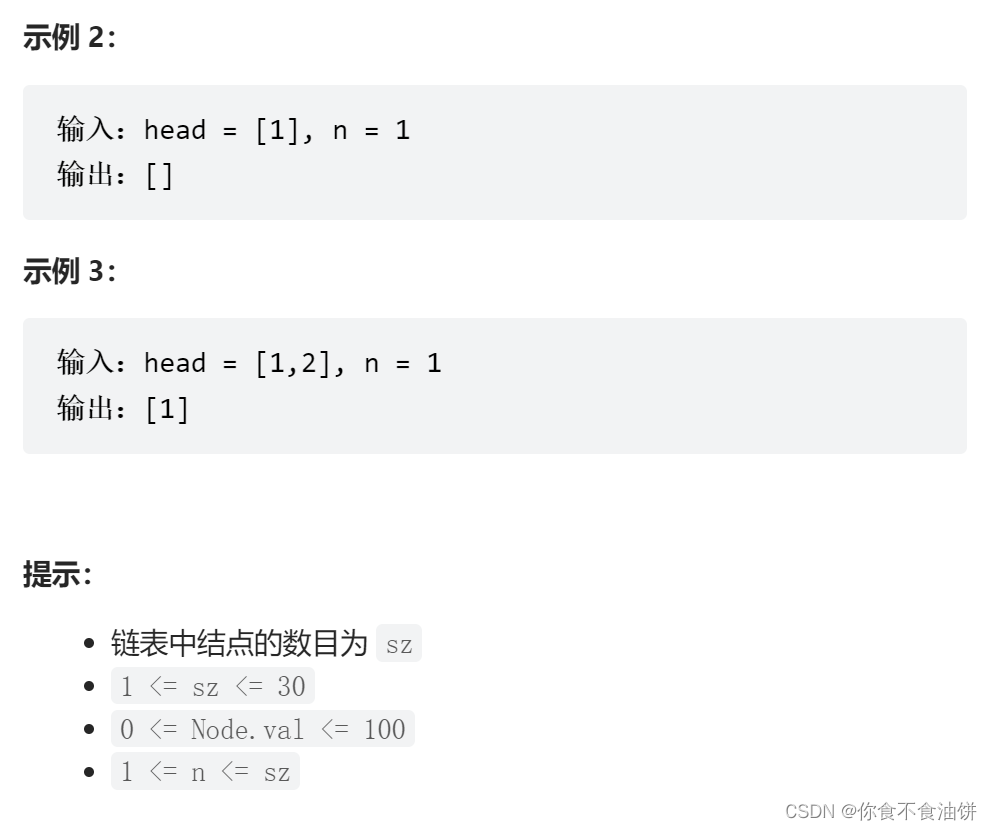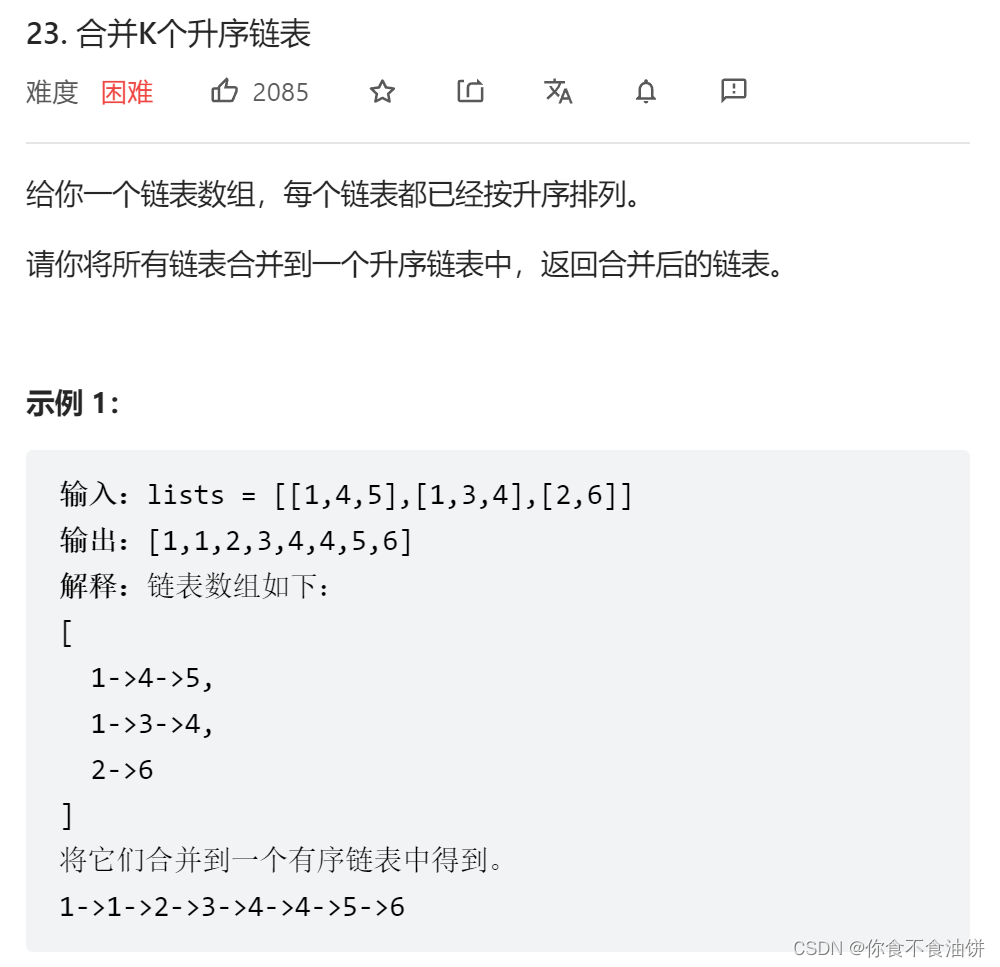1、合并两个有序链表
题目描述:


思路:合并两个有序链表也是一个很经典的题目,看到这道题目,不少的小伙伴估计会有种似曾相识的感觉,是不是有点像,合并两个数组哈哈哈哈,所以我们首先先用笨方法(依次比较)l来试试
1、依次比较
看看代码:
public ListNode mergeTwoLists(ListNode list1, ListNode list2) {
ListNode cur = new ListNode(0);
ListNode result = cur;
ListNode temp1 = list1;
ListNode temp2 = list2;
while (temp1 != null && temp2 != null){
if (temp1.val < temp2.val){
cur.next = temp1;
temp1 = temp1.next;
cur = cur.next;
}else {
cur.next = temp2;
temp2 = temp2.next;
cur = cur.next;
}
}
if (temp1 == null){
while (temp2 != null){
cur.next = temp2;
temp2 = temp2.next;
cur = cur.next;
}
}else if (temp2 == null){
while (temp1 != null){
cur.next = temp1;
temp1 = temp1.next;
cur = cur.next;
}
}
return result.next;
}时间复杂度:O(n)
空间复杂度:O(1)
2、递归
思路:既然是递归我们就会想到这道题的递归三要素
- 终止条件:list1为空,或者list2为空
- 返回值:每一层都返回已经排序好的链表
- 本机递归内容:如果list1.val更小,则将list1.next和下一级排序好的链表连接;list2反之亦然
我们看看代码:
public ListNode mergeTwoLists(ListNode list1, ListNode list2) {
if (list1 == null) return list2;
if (list2 == null) return list1;
if (list1.val<list2.val){
list1.next = mergeTwoLists(list1.next,list2);
return list1;
}else {
list2.next = mergeTwoLists(list1,list2.next);
return list2;
}
}时间复杂度:O(m+n),m为list1的长度,n为list2的长度
2、合并k个升序链表
题目描述:

思路:拿到题目,首先我们先审题,合并k条,其实本质上和合并2条升序链表没有区别,我们只需要拆分,把k条链表,拆分成若干个2条链表,思路瞬间是不是清晰了!
至于如何拆分,我不知道大家有没有了解过 归并排序 ,大家又不了解的可以移步归并排序
归并排序里面用到的思想就是分治算,先分后治,先拆分,后合并,是不是跟咱们这道题有异曲同工之妙,先把链表拆分,再把链表合并;唯一不同的是归并排序时,我们是拆分同一个数组,而现在我们是拆分k条不同的链表,不过我们要得到的效果都是一样的!
了解完之后,我们不妨看看代码:
public ListNode mergeKLists(ListNode[] lists) {
if (lists.length < 1) return null;
return mergeLists(lists, 0, lists.length);
}
public ListNode mergeLists(ListNode[] lists, int left, int right) {
if (left >= right) return lists[left];
int mid = (left + right) / 2;
//先分
ListNode l1 = mergeLists(lists, left, mid);
ListNode l2 = mergeLists(lists, mid + 1, right);
//后治
return mergeTwoLists(l1, l2);
}
public ListNode mergeTwoLists(ListNode list1, ListNode list2) {
if (list1 == null) return list2;
if (list2 == null) return list1;
if (list1.val < list2.val) {
list1.next = mergeTwoLists(list1.next, list2);
return list1;
} else {
list2.next = mergeTwoLists(list1, list2.next);
return list2;
}
}这里为了优化我们合并算法的时间复杂度,我们可以采用迭代算法,也就是第一题的第一张方法替代这个合并递归方法,会加快不少时间
public ListNode mergeKLists(ListNode[] lists) {
if (lists.length < 1) return null;
return mergeLists(lists, 0, lists.length);
}
public ListNode mergeLists(ListNode[] lists, int left, int right) {
if (left >= right) return lists[left];
int mid = (left + right) / 2;
//先分
ListNode l1 = mergeLists(lists, left, mid);
ListNode l2 = mergeLists(lists, mid + 1, right);
//后治
return mergeTwoLists(l1, l2);
}
public ListNode mergeTwoLists(ListNode list1, ListNode list2) {
ListNode cur = new ListNode(0);
ListNode result = cur;
ListNode temp1 = list1;
ListNode temp2 = list2;
while (temp1 != null && temp2 != null){
if (temp1.val < temp2.val){
cur.next = temp1;
temp1 = temp1.next;
cur = cur.next;
}else {
cur.next = temp2;
temp2 = temp2.next;
cur = cur.next;
}
}
if (temp1 == null){
while (temp2 != null){
cur.next = temp2;
temp2 = temp2.next;
cur = cur.next;
}
}else if (temp2 == null){
while (temp1 != null){
cur.next = temp1;
temp1 = temp1.next;
cur = cur.next;
}
}
return result.next;
}总结:合并升序链表,也是笔试常考的一道题,大家很有必要学习一下~























 2802
2802











 被折叠的 条评论
为什么被折叠?
被折叠的 条评论
为什么被折叠?










